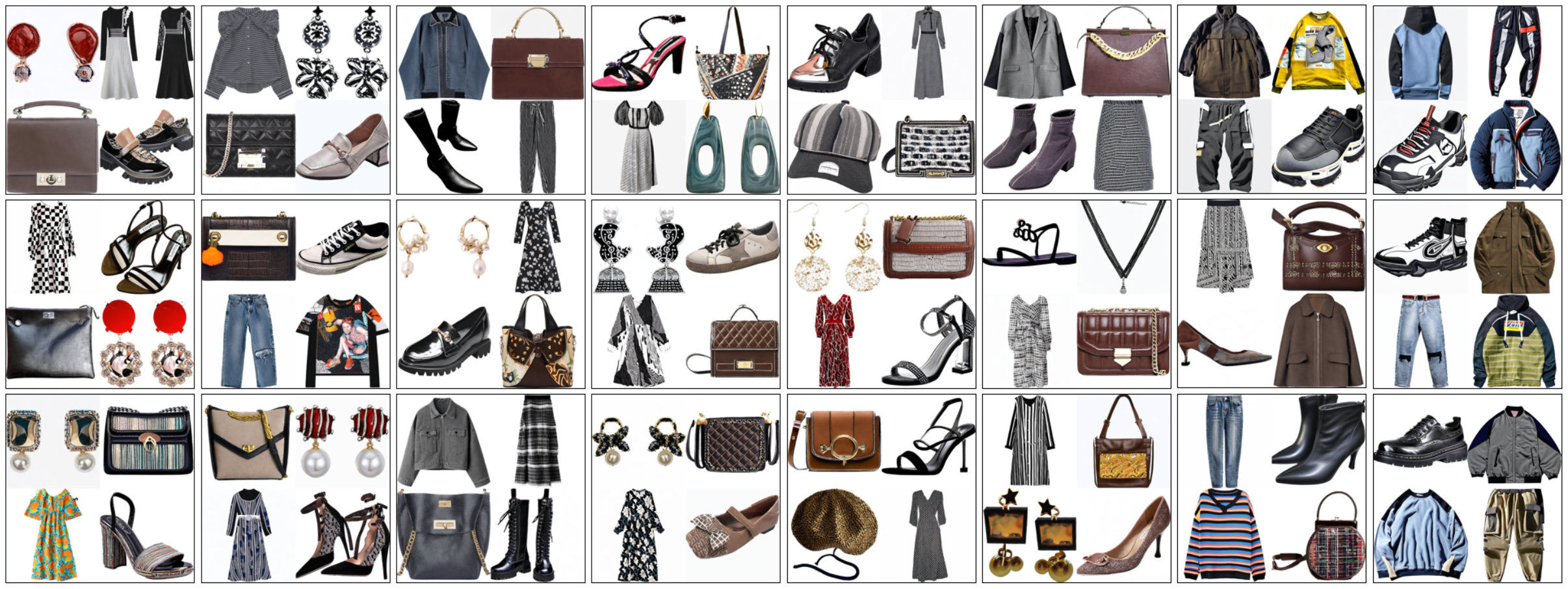This is the pytorch implementation of our paper at SIGIR 2024:
Diffusion Models for Generative Outfit Recommendation
Yiyan Xu, Wenjie Wang, Fuli Feng, Yunshan Ma, Jizhi Zhang, Xiangnan He
An overview of DiFashion: it gradually corrupts outfit images with Gaussian noise in the forward process, followed by a parallel conditional denoising process to reconstruct these images. The denoising process is guided by three conditions: category prompt, mutual condition, and history condition.

- Generated images (enclosed in small black squares within each outfit) for the PFITB task.

- Generated outfits for the GOR task.

- Anaconda 3
- python 3.8.13
- torch 2.0.1
- torchvision 0.15.2
- Pillow 9.0.1
- numpy 1.24.4
- transformers 4.32.1
- open-clip-torch 2.20.0
- accelerate 0.20.3
- diffusers 0.18.2
- xformers 0.0.22
- pytorch-fid 0.3.0
- lpips 0.1.4
The experimental data are in './datasets' folder, including iFashion and Polyvore-U. Each dataset consists of the following files:
-
train.npy: dict with four keysuids,oids,outfits, andcategoryfor training.{ 'uids':[uid1,...], # list of user ids 'oids':[[oid1,...],...], # user interacted outfit ids 'outfits':[[[iid1,iid2,iid3,iid4],...],...], # item ids within each interacted outfit 'category':[[[cid1,cid2,cid3,cid4],...],...] # category ids within each interacted outfit } -
valid_grd_dict.npy&test_grd_dict.npy: same data format astrain.npy. -
fitb_valid.npy&fitb_test.npy: same data format astrain.npyfor validation and test, respectively. For the Fill-In-The-Blank task, we randomly set one item id of each outfit to be0, indicating the missing item that needs to be filled in. -
fitb_valid_dict.npy&fitb_test_dict.npy: another format offitb_valid.npyandfitb_test.npy.{ uid1:{ oid1:[iid1,iid2,iid3,iid4], oid2:[...], ... }, ... } -
valid_grd.npy&test_grd.npy: ground-truth outfit information of each oid within validation and test sets.{ oid1:{ 'outfits':[iid1,iid2,iid3,iid4], 'category':[cid1,cid2,cid3,cid4] }, ... } -
fitb_valid_retrieval_candidates.npy&fitb_test_retrieval_candidates.npy: we randomly sample 4 items from the item set to serve as negative samples, which are combined with the ground-truth item to form the entire candidate set for each outfit infitb_valid.npyandfitb_test.npyfor retrieval.{ uid1:{ oid1:[cand1,cand2,cand3,cand4,cand5] # cand1 is the ground-truth oid2:[...], ... }, ... } -
train_history.npy,valid_history.npy&test_history.npy: user interacted category id and corresponding item id.{ uid1:{ cid1:[iid1,iid2,...], # user interacted items within category cid1 cid2:[...], ... }, ... } -
id_cate_dict.npy: category id and corresponding semantic category.{0:'skirt', 1:"women's canva shoe", ...} -
cate_iid_dict.npy&iid_cate_dict.npy: the correspondance between category id and item id. -
To acquire additional data, kindly retrieve the necessary files from iFashion-cloud and Polyvore-cloud and put them into corresponding data path, respectively. Each source comprises two files and one folder.
-
/processed: data processed for training, validation, test and evaluation. If you didn't download the files in the folder,- You can set the argument '--data_processed' to False in
/DiFashion/train.py, which will initiate the processing of above base data into a suitable format and save them in the folder '/datasets/dataset_name/processed'. - Run the code '/Evaluation/extract_hist_embs.py' to obtain the remaining files required for evaluation.
- You can set the argument '--data_processed' to False in
-
all_item_image_paths.npy: list of item image paths arranged according to item ids. -
cnn_features_clip.npy: extracted clip image embeddings of all the images arranged according to item ids. You can find relevant code in '/Evaluation/extract_hist_embs.py'.
-
For item images of iFashion,
-
Download item information
item_info.npyfrom here with the format:{ iid1:{ 'original iid':ori_iid, 'category':semantic_category, 'url':image_url }, ... } -
Download each image through the url into path '/img_folder_path/semantic_category/ori_iid.png', corresponding to the image path format in
all_item_image_paths.npy. -
Process these item images via function
process_image.from PIL import Image def process_image(image): image = convert_to_rgb(image) image = pad_to_square(image) target_size = (512, 512) image = resize_image(image, target_size) return image def convert_to_rgb(image): if image.mode != 'RGB': if image.mode != "RGBA": image = image.convert('RGBA') background = Image.new("RGBA", image.size, (255,255,255)) result_image = Image.alpha_composite(background, image) result_image = result_image.convert("RGB") return result_image else: return image def pad_to_square(image): # Transform the image into a square format, ensuring a uniform white background. width, height = image.size padding = abs(width - height) // 2 if width < height: padding_mode = (padding, 0) else: padding_mode = (0, padding) squared_image = Image.new('RGB', (max(width, height), max(width, height)), (255, 255, 255)) squared_image.paste(image, padding_mode) return squared_image def resize_image(image, target_size): resized_image = image.resize(target_size, Image.LANCZOS) return resized_image
-
Add an empty image into the image folder path without semantic category.
from PIL import Image empty_img = Image.new('RGB', (512, 512), (255,255,255)) # a pure white image folder_path = '/img_folder_path/' empty_img.save(os.path.join(folder_path, "empty_image.png"))
For item images of Polyvore-U,
- Download all the images from here.
- Unzip the file
291x291.tar.gzand put it into an appropriate path '/path/to/291x291'. - Add an empty image into the image folder.
from PIL import Image empty_img = Image.new('RGB', (512, 512), (255,255,255)) # a pure white image folder_path = '/path/to/291x291' empty_img.save(os.path.join(folder_path, "empty_image.png"))
Please configure correct paths of all data in train.py and set appropriate gpu id in config.yaml.
cd ./DiFashion
sh run_eta0.1.sh
- Download the checkpoint released by us from here.
- Put the checkpoint into appropriate folder.
- Configure correct paths of all data in
inf4eval.pyand set appropriate gpu id inconfig.yaml. - Run inf4eval.py
cd ./DiFashion
sh run_inf4eval.sh
- Download finetuned inception from here and put it into '/Evaluation/finetuned_inception/'.
- Run the evaluation code through the
.shfiles. For example, to evaluate the performance of DiFashion on iFashion dataset within the Fill-In-The-Blank task, execute the corresponding evaluation codeevaluate_fitb.pyusing the providedrun_eval_fitb.sh.
cd ./Evaluation
sh run_eval_fitb.sh ifashion DiFashion all test log 3